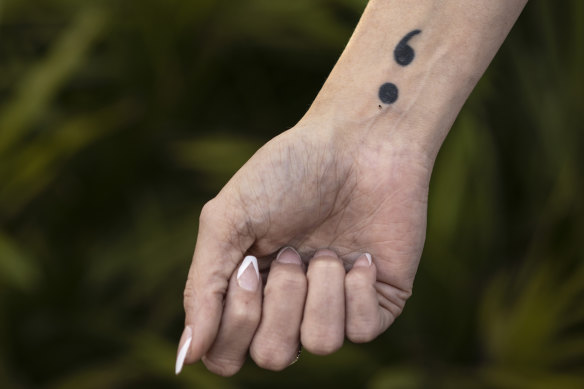Kurt Vonnegut despised them. Ernest Hemingway avoided them. Cormac McCarthy – the acclaimed American author who died last week – was similarly dismissive. “There’s no need to block the page up with weird little marks,” McCarthy told Oprah Winfrey in 2007. “If you write properly you shouldn’t need to punctuate.”
Meanwhile, other writers have been addicted to these “weird little marks”, sprinkling them throughout their prose with gluttonous abandon. Louisa May Alcott’s Little Women features around six per page. Herman Melville went further by using eight per page and even included one in the title of Moby-Dick; or, The Whale.

Survivors of mental health struggles have embraced the semicolon and often get it tattooed on their bodies.Credit: Thomas Simonetti
I refer, of course, to that most divisive of punctuation marks: the semicolon. A full stop perched on top of a comma may appear an innocuous combination, but talk of the semicolon can quickly turn into an argument when punctuation pedants get together.
Turn Every Page, a film released last year about the 50-year relationship between legendary American biographer Robert Caro and his editor Robert Gottleib, showed how the pair bickered over semicolons (Caro is a big fan; Gottleib was not). “The semicolon is worth fighting a civil war over,” Gottleib, who also died last week, insists in the film.
In my day job as a political reporter I strive for fairness, but when it comes to this civil war I must declare a clear bias. My love affair with the semicolon began when I was 15 and became obsessed with the film The Hours, a reimagining of Virginia Woolf’s Mrs Dalloway. When I read Woolf’s 1925 novel I was instantly swimming in a sea of semicolons.
Here’s a typical sentence from the book’s first page: “In people’s eyes, in the swing, tramp, and trudge; in the bellow and the uproar; the carriages, motor cars, omnibuses, vans, sandwich men shuffling and swinging; brass bands; barrel organs; in the triumph and the jingle and the strange high singing of some aeroplane overhead was what she loved; life; London; this moment of June.”

The late author Cormac McCarthy disliked conspicuous punctuation. “There’s no need to block the page up with weird little marks.”Credit: AP
It’s a lot to take in, I know. But I was entranced by Woolf’s melodic stream-of-consciousness style. By using the semicolon to string her sentences together, she conveyed the thrill her protagonist felt about being part of the hustle and bustle of a big city.
One reason the semicolon is so divisive is because, unlike other punctuation marks, it is almost never essential. It is usually used to connect two phrases that are related, but could otherwise be separate sentences. This flexibility means it can go in and out of vogue – the semicolon reached its zenith of popularity in the 19th century, when a florid writing style was fashionable. In today’s more minimalist era, to come out as a member of #teamsemicolon is to risk being labelled an antiquated elitist. “They are transvestite hermaphrodites representing absolutely nothing,” claimed Vonnegut, the author of Slaughterhouse-Five. “All they do is show you’ve been to college.”
Stay connected with us on social media platform for instant update click here to join our Twitter, & Facebook
We are now on Telegram. Click here to join our channel (@TechiUpdate) and stay updated with the latest Technology headlines.
For all the latest Life Style News Click Here
For the latest news and updates, follow us on Google News.
